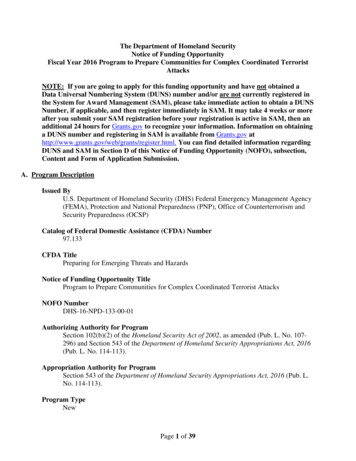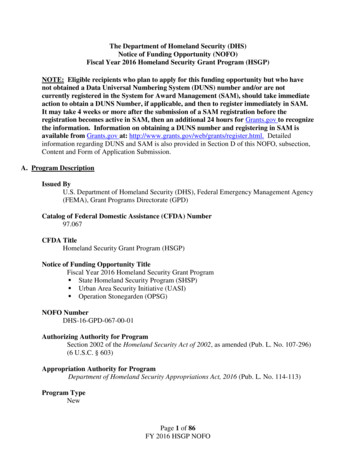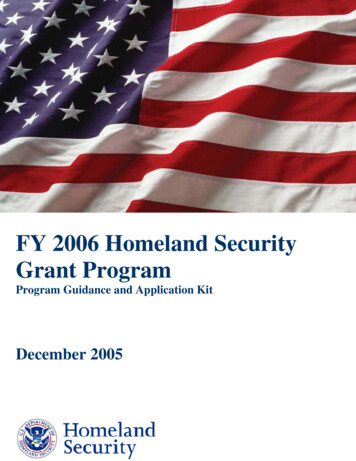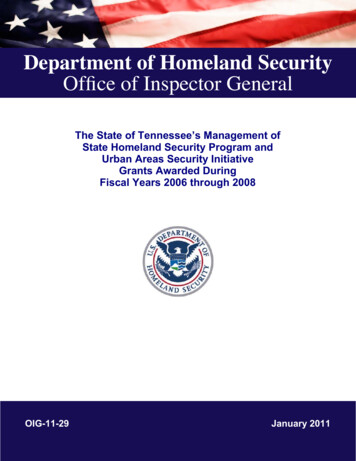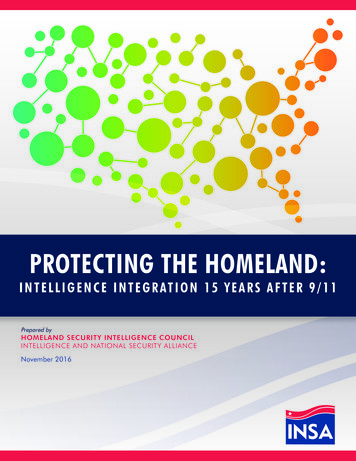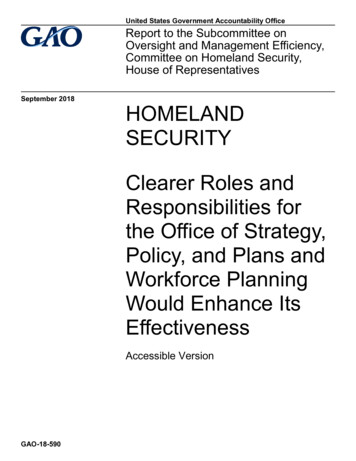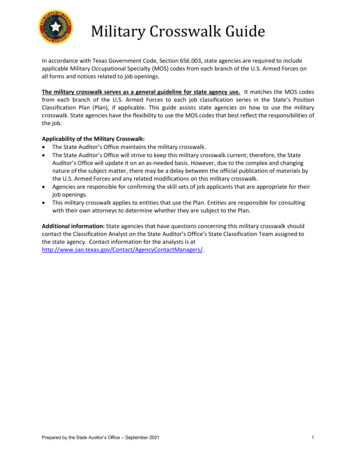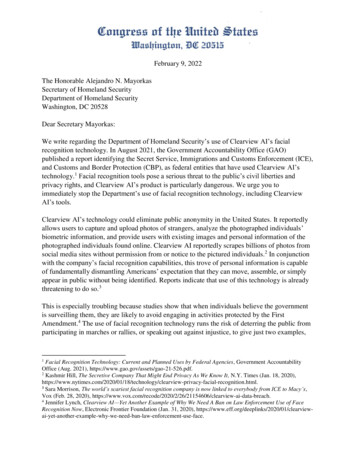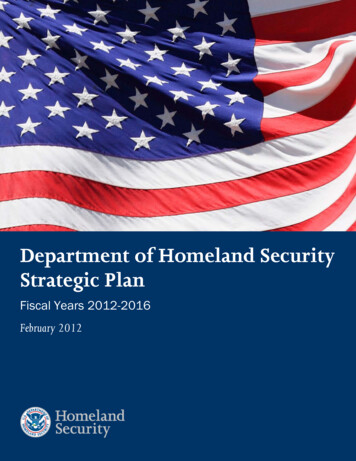
Transcription
Department of Homeland SecurityStrategic PlanFiscal Years 2012-2016February 2012
Message from the SecretaryFebruary 13, 2012I am pleased to submit the U.S. Department of Homeland Security (DHS) Strategic Planfor Fiscal Years (FY) 2012-2016 (Plan). The Plan outlines our vision forhomeland security as defined in the Department's Quadrennial HomelandSecurity Review (QHSR), which established a unified, strategic frameworkfor homeland security missions and goals, and the DHS Bottom-Up Review(BUR), a complementary effort to align DHS's programmatic activities andorganizational structure to better serve those missions and goals. The Planalso continues the Department's efforts to prioritize frontline operationswhile maximizing the effectiveness and efficiency of every taxpayer dollarw e receive.The QHSR unites the Department's efforts behind five key missions: To secure our country from terroristthreats and enhance security; secure our borders; enforce our Nation's immigration laws; securecyberspace; and build resilience to disasters. As described in the BUR, the Department's FY 2012 BudgetSubmission and FY 2012-2016 Future Years Homeland Security Program Report, DHS also providesessential support to national and economic security, and continues to mature and strengthen as aninstitution.Pursuant to the new Government Performance and Results Modernization Act of 2010 (P. L. 111-352) and the governingpreparation and submission requirements of the Office of Management and Budget's Circular A-ll, thePlan emphasizes the Department's mission performance priorities. Its long-range view utilizes the missionstructure of the QHSR, the FY 2012-201 6 Future Years Homeland Security Program, the mutually supporting business function descriptions within the Homeland Security Enterprise Architecture, andultimately the overarching direction stated in the National Security Strategy (2 0 10).The U.S. Department of Homeland Security Strategic Plan for Fiscal Years 2012-2016 articulates the hard work andsacrifice that our men and w omen face with tremendous skill and dedication every day. While our dutiesare wide-ranging, our goal is clear: a safe, secure, and resilient America.Yours very truly,Janet Napolitano
Table of ContentsI.About This Plan1II.Department Vision, Mission, and Organization Chart2III.Mission Goals and Objectives3IV.Providing Essential Support to National and Economic Security19V.Maturing and Strengthening DHS23Appendix A:Appendix B:Appendix C:Appendix D:Linking Strategy and PerformanceDHS Priority GoalsHomeland Security Strategic ContextQHSR Stakeholder EngagementA-1B-1C-1D-1DHS Component and Office Acronyms Listii
I. About This PlanThe U.S. Department of Homeland Security Strategic Plan for Fiscal Years (FY) 2012-2016 presents the Department’sgoals, derived from the conclusions of the Quadrennial Homeland Security Review (QHSR) and theBottom-Up Review (BUR). The goals include objectives and key performance indicators that are essentialfor implementation and execution of the Department’s responsibilities.This Plan, like the QHSR process that preceded it, reflects the core principles identified in the OpenGovernment Plan ernment-directive]. Thesethree principles—transparency, public participation, and collaboration—are the basic tenets of OpenGovernment. This Strategic Plan describes the Department’s Strategic Performance Plan Measures in thecontext of the QHSR and the homeland security missions. The Plan continues the Department’s efforts toprioritize frontline operations while maximizing the effectiveness and efficiency of every taxpayer dollarthe Department receives. The Plan also describes the Department’s efforts to provide essential support tonational and economic security, and to mature and strengthen DHS as an institution.The Plan is built from the deliberations and conclusions of the QHSR, the BUR, and the Department’s FY2012 budget request and FY 2012-2016 Future Years Homeland Security Program, as well as the strategicperformance measures articulated in the Department’s FY 2010-2012 Annual Performance Report. TheDepartment is committed to improving performance measurement and accountability by increasing thequality of the Department’s performance measures and linking those measures to the mission outcomesarticulated in the QHSR. DHS is continuously assessing all of its performance measures to improvealignment with the QHSR and create a comprehensive performance plan that will provide the basis forstrategic planning and management controls.The Plan is a Departmental management tool for strategic achievement of the responsibilities set forth inthose documents. The Plan satisfies the requirements of the Government Performance and Results Modernization Act of2010 (P. L. 111-352) (GPRA) and the Office of Management and Budget’s Circular A-11 to publish anAgency Strategic Plan.Department strategic capstone products are located at our public website at http://www.dhs.gov/qhsr.For more information, contactDepartment of Homeland SecurityOffice of PolicyOffice of Strategic PlansWashington, D.C. 20528Information may also be requested by sending an email to STRATEGY@dhs.gov.1
II. Department Vision and MissionVISIONA homeland that is safe, secure, and resilient against terrorism and other hazards.DEPARTMENT MISSIONWe will lead efforts to achieve a safe, secure, and resilient homeland. We will counter terrorism andenhance our security; secure and manage our borders; enforce and administer our immigration laws;protect cyber networks and critical infrastructure; and ensure resilience from disasters. We will accomplishthese missions while providing essential support to national and economic security and maturing andstrengthening both the Department of Homeland Security and the homeland security enterprise.DEPARTMENT of HOMELAND SECURITYORGANIZATION CHART 11 The Consolidated Appropriations Act of 2012 (P. L. 112-74) terminated the Office of Counternarcotics Enforcement and authorized the transferof its policy development and coordination responsibilities to the Office of Policy by March 30, 2012.2
III. Mission Goals and ObjectivesMISSION 1: PREVENTING TERRORISM AND ENHANCING SECURITYProtecting the United States from terrorism is the cornerstone of homeland security.DHS’scounterterrorism responsibilities focus on three goals: preventing terrorist attacks; preventing theunauthorized acquisition, importation, movement, or use of chemical, biological, radiological, and nuclearmaterials and capabilities within the United States; and reducing threats to and vulnerability of criticalinfrastructure, key resources, essential leadership, and major events from terrorist attacks and other hazards.Goal 1.1: Preventing Terrorist AttacksMalicious actors are unable to conduct terrorist attacks within the United States.The United States has made significant progress in securing the nation from terrorism since theSeptember 11, 2001, attacks. Nevertheless, work remains as the terrorist threats facing thecountry have evolved in the last ten years, and continue to change. Created with the foundingprinciple of protecting the American people from terrorist and other threats, DHS and its manypartners, internationally, across the federal, state, and local governments, tribal and territorial,public and private sectors, and communities across the country have strengthened thehomeland security enterprise to better mitigate and defend against dynamic threats.Objective 1.1.1: Understand the threatCollect, gather, analyze, and appropriately share intelligence and other information oncurrent and emerging threats.Objective 1.1.2: Deter and disrupt operationsDeter, detect, and disrupt surveillance, rehearsals, and execution of operations byterrorists and other malicious actors.Objective 1.1.3: Protect against terrorist capabilitiesProtect potential targets against the capabilities of terrorists, malicious actors, and theirsupport networks to plan and conduct operations.Objective 1.1.4: Stop the spread of violent extremismPrevent and deter domestic violent extremism and the radicalization process thatcontributes to it.3
Objective 1.1.5: Engage communitiesIncrease community participation in efforts to deter terrorists and other maliciousactors and mitigate radicalization toward violence.Goal 1.2: Prevent the unauthorized acquisition or use of chemical,biological, radiological, and nuclear (CBRN) materials and capabilitiesMalicious actors, including terrorists, are unable to acquire or move dangerous chemical,biological, radiological, and nuclear (CBRN) materials or capabilities to or within the UnitedStates or deterred from doing so.While the Nation remains committed to preventing all attacks by terrorists and other malicious actors,CBRN attacks pose a far greater potential to cause catastrophic consequences. Consequently, particularattention must be paid to the security of dangerous CBRN materials, weapons, and technologies.Objective 1.2.1: Anticipate emerging threatsIdentify and understand potentially dangerous actors, technologies, and materials.Objective 1.2.2: Control access to CBRNPrevent terrorists and other malicious actors from gaining access to dangerous CBRNmaterials, weapons, and technologies.Objective 1.2.3: Control movement of CBRNPrevent the illicit movement of dangerous CBRN materials, weapons, andtechnologies.Objective 1.2.4: Protect against hostile use of CBRNIdentify the presence of, effectively locate, interdict, disable, attribute, or prevent thehostile use of CBRN.Goal 1.3: Manage Risks to Critical Infrastructure, Key Leaders, and EventsKey sectors actively work to reduce vulnerability to attack or disruption.Over the past ten years, DHS has made significant strides in enhancing the security of the nation’scritical physical infrastructure as well as its cyber infrastructure and networks. The American way of lifedepends upon the effective functioning of the Nation’s critical infrastructure and key resources, and theprotection of key leaders and events. Although considerable advances have been made in identifyingcritical infrastructure assets and systems, and understanding the current, emerging, and future risks to4
those infrastructures, the breadth of the Nation’s infrastructure, its criticality, and its increasing relianceon cyberspace, necessitates continued diligence.Objective 1.3.1: Understand and prioritize risks to critical infrastructureIdentify, attribute, and evaluate the most dangerous threats to critical infrastructureand those categories of critical infrastructure most at risk.Objective 1.3.2: Protect critical infrastructurePrevent high-consequence events by securing critical infrastructure assets, systems,networks, and functions—including linkages through cyberspace—from attacks ordisruption.Objective 1.3.3: Make critical infrastructure resilientEnhance the ability of critical infrastructure systems, networks, and functions towithstand and rapidly recover from damage and disruption and adapt to changingconditions.Objective 1.3.4: Protect governmental leaders, facilities, and special eventsPreserve continuity of government and ensure security at events of nationalsignificance.Highlighted Mission 1 Performance MeasuresThe table below presents highlighted performance measures associated with gauging results forPreventing Terrorism and Enhancing Security. For detailed information on the measures listedbelow, and a complete list of all measures associated with this mission, please see the FY 2011-2013Annual Performance Report at http://www.dhs.gov/xabout/budget/editorial 0430.shtm.Highlighted Mission 1 Performance MeasuresPlanned TargetsFY 2016FY 2012FY 2013Percent of intelligence reports rated “satisfactory” or higher in customer feedback thatenable customers to understand the threat (AO)80%80%80%Percent of international air enplanements vetted against the terrorist watch list throughSecure Flight (TSA)100%100%100%Percent of inbound air cargo screened on international passenger flights originatingfrom outside the United States and Territories (TSA)85%100%100%Percent of law enforcement officials trained in methods to counter terrorism and otherviolent acts that rate the training as effective (DHS HQ - CRCL)82%84%90%5
Highlighted Mission 1 Performance MeasuresFY 2012Planned TargetsFY 2016FY 2013Percent of inspected high-risk chemical facilities in compliance with the ChemicalFacility Anti-terrorism Standards (NPPD)20%35%70%Percent of total U.S. Secret Service protection activities that are incident-free forprotection of national leaders, foreign dignitaries, designated protectees and othersduring travel or at protected facilities (USSS)100%100%100%6
MISSION 2: SECURING AND MANAGING OUR BORDERSThe protection of the Nation’s borders—land, air, and sea—from the illegal entry of people, weapons,drugs, and other contraband while facilitating lawful travel and trade is vital to homeland security, as wellas the Nation’s economic prosperity. The Department’s border security and management efforts focus onthree interrelated goals: effectively securing U.S. air, land, and sea borders; safeguarding and streamlininglawful trade and travel; and disrupting and dismantling transnational criminal and terrorist organizations.Goal 2.1: Secure U.S. Air, Land, and Sea BordersPrevent the illegal flow of people and goods across U.S. air, land, and sea borders whileexpediting the safe flow of lawful travel and commerce.Over the past several years, DHS has deployed historic levels of personnel, technology, andresources to the Southwest border, and made critical security improvements along theNorthern and maritime borders while facilitating the lawful transit of people and goods acrossour borders. Through the collection, analysis, and proper sharing of information, the use ofscreening and identification verification techniques, the employment of advanced detectionand other technologies, the use of “trusted traveler” or “trusted shipper” approaches, andcooperation with our international partners and the private sector, we can achieve security atour borders, enforce the laws, and ensure our prosperity and freedom by expediting lawfultravel and commerce.Objective 2.1.1: Prevent illegal entryPrevent the illegal entry of people, weapons, drugs, contraband, and dangerous goods,and protect against cross-border threats to health, food, environment, and agriculture,while facilitating the safe flow of lawful travel and commerce.Objective 2.1.2: Prevent illegal export and exitPrevent the illegal export of weapons, proceeds of crime, and other dangerous goods,and the exit of malicious actors.Goal 2.2: Safeguard Lawful Trade and TravelEnsure security and resilience of global movement systems.The global economy is increasingly a seamless economic environment connected by systemsand networks that transcend national boundaries. The United States is deeply linked to othercountries through the flow of goods and services, capital and labor, and information andtechnology across our borders. As much as these global systems and networks are critical tothe United States and our prosperity, their effectiveness and efficiency also make them targetsfor exploitation by our adversaries, terrorists, and criminals. Thus, border security cannotbegin simply at our borders. The earlier we can identify, understand, interdict, and disrupt7
plots and illegal operations, the safer we will be at home. In other words, our borders shouldnot be our first line of defense against global threats. This premise focuses on buildingpartnerships to secure key nodes and conveyances in the global trading and transportationnetworks, as well as to managing the risks posed by people and goods in transit. Moreover,sustaining a competitive U.S. economy and a stable global trading system require us to workwith international partners and the private sector to secure global movement systems. Thesesame goals are also served by ensuring the free, lawful movement of people and commercethrough the global economy and across U.S. borders in a manner that does not impaireconomic vitality, while at the same time safeguarding privacy, civil rights, and civil liberties.Objective 2.2.1: Secure key nodesPromote the security and resilience of key nodes of transaction and exchange within the globalsupply chain.Objective 2.2.2: Secure conveyancesPromote the security and resilience of conveyances in the key global trading and transportationnetworks.Objective 2.2.3: Manage the risk of people and goods in transitPositively identify and determine the risk posed to the country and the larger global movementsystem by people seeking to come to the United States as well as goods in transit, as far inadvance as possible.Goal 2.3: Disrupt and Dismantle Transnational Criminal OrganizationsDisrupt and dismantle transnational organizations that engage in smuggling andtrafficking across the U.S. border.Criminals, terrorist networks, and other malicious actors continue to seek to exploit the sameinterconnected systems and networks of the global economy for nefarious purposes, or createtheir own illicit pathways for smuggling and trafficking—of illegal drugs, illegal migrants,terrorists, and highly dangerous weapons. When these organizations or actors are successful,they also may increase corruption, levels of violence, and engage in a wide variety of othercriminal activities, such as money laundering, bulk cash smuggling, and intellectual propertycrime, which threaten the rule of law, potentially endanger lives, and generate widerdestabilization. Thus, our border strategy must also focus on reducing the power andcapability of these transnational criminal and terrorist organizations.8
Objective 2.3.1: Identify, disrupt, and dismantle transnational criminal and terroristorganizationsDisrupt transnational criminal or terrorist organizations involved in cross-border smuggling,trafficking, or other cross-border crimes, dismantle their infrastructure, and apprehend theirleaders.Objective 2.3.2: Disrupt illicit pathwaysIdentify, disrupt, and dismantle illicit pathways used by criminal and terrorist organizations.Highlighted Mission 2 Performance MeasuresThe table below presents highlighted performance measures associated with gauging results forSecuring and Managing Our Borders. For detailed information on the measures listed below, and acomplete list of all measures associated with this mission, please see the FY 2011-2013 AnnualPerformance Report at http://www.dhs.gov/xabout/budget/editorial 0430.shtm.Highlighted Mission 2 Performance MeasuresFY 2012Planned TargetsFY 2016FY 2013Number of apprehensions on the Southwest Border between the ports of entry (CBP) 371,000 352,000 301,000Percent of detected conventional aircraft incursions resolved along all borders of theUnited States (CBP)100%100%100% 35 30 30Percent of foreign airports serving as last point of departure in compliance with leadingsecurity indicators (TSA)100%100%100%Percent of maritime facilities in compliance with security regulations as they have notreceived a notice of violation and/or civil penalty (USCG)100%99%99%Percent of imports compliant with applicable U.S. trade laws (CBP)98%98%98%Percent of significant high-risk transnational criminal investigations that result in adisruption or dismantlement (ICE)16%16%16%Amount of currency seized on exit from the United States (in millions) 2 (CBP)2The deterrence effect of conducting exit/outbound screening operations is expected to result in decreasing seizures over time based on currentsurge capacity.9
MISSION 3: ENFORCING AND ADMINISTERING OUR IMMIGRATIONLAWSThe success of our Nation’s immigration policy plays a critical role in advancing homeland security. DHS isfocused on smart and effective enforcement of U.S. immigration laws while streamlining and facilitatingthe legal immigration process. The Department has fundamentally reformed immigration enforcement,focusing on identifying and removing criminal aliens who pose a threat to public safety and targetingemployers who knowingly and repeatedly break the law.Goal 3.1: Strengthen and Effectively Administer the Immigration SystemPromote lawful immigration, expedite administration of immigration services, and promote theintegration of lawful immigrants into American society.Effective administration of the immigration system depends on ensuring that immigration decisions areimpartial, lawful, and sound; that the immigration system is interactive and user friendly; that policyand procedural gaps are systematically identified and corrected; and those vulnerabilities that wouldallow persons to exploit the system are eliminated. In addition, effectively administering theimmigration system includes efforts to integrate lawful immigrants into American society.Objective 3.1.1: Promote lawful immigrationClearly communicate with the public about immigration services and procedures.Objective 3.1.2: Effectively administer the immigration services systemCreate a user-friendly system that ensures impartial, consistent, and prompt decisions.Objective 3.1.3: Promote the integration of lawful immigrants into American societyProvide leadership, support, and opportunities to lawful immigrants to facilitate theirintegration into American society and foster community cohesion.Goal 3.2: Prevent Unlawful ImmigrationReduce conditions that encourage foreign nationals to illegally enter and remain in theUnited States, while identifying and removing those who violate our laws.To prevent illegal immigration, agencies charged with immigration administration andenforcement activities must address conditions and factors that create incentives for thoseillegally entering and staying within the United States. Enforcement efforts must prioritize theidentification and removal of dangerous foreign nationals who threaten our national securityor the safety of our communities and must include safe and humane detention conditions andrespect for due process and civil rights as accorded by law.10
Objective 3.2.1: Reduce demandEliminate the conditions that encourage illegal employment.Objective 3.2.2: Eliminate systemic vulnerabilitiesPrevent fraud, abuse, and exploitation, and eliminate other systemic vulnerabilities thatthreaten the integrity of our immigration system.Objective 3.2.3: Prevent entry or admissionPrevent entry or admission of criminals, fugitives, dangerous and unauthorized foreignnationals and other unauthorized entrants.Objective 3.2.4: Arrest, detain, prosecute, and removeArrest, detain, prosecute, and remove criminal, fugitive, dangerous, and otherunauthorized foreign nationals consistent with due process and civil rights protections.Highlighted Mission 3 Performance MeasuresThe table below presents highlighted performance measures associated with gauging results forEnforcing and Administering Our Immigration Laws. For detailed information on the measureslisted below, and a complete list of all measures associated with this mission, please see the FY2011-2013 Annual Performance Report at http://www.dhs.gov/xabout/budget/editorial 0430.shtm.Highlighted Mission 3 Performance MeasuresPercent of Form N-400, Application for Naturalization, decisions determined byquarterly quality reviews to have correctly followed adjudication procedures (USCIS)Planned TargetsFY 2016FY 2012FY 201396%96%96% 5 months 5 months 5 monthsOverall customer service rating of the immigration process (USCIS)80%80%80%Number of employers arrested or sanctioned for criminally hiring illegal labor Average of processing cycle times for naturalization applications (N-400) (USCIS)Number of convicted criminal aliens removed per fiscal year (ICE)Average length of stay in detention of all convicted criminal aliens prior to removalfrom the United States (in days) (ICE)Percent of detention facilities found in compliance with the national detention standardsby receiving an inspection rating of acceptable or greater on the last inspection (ICE)11
MISSION 4: SAFEGUARDING AND SECURING CYBERSPACECyberspace is highly dynamic and the risks posed by malicious cyber activity often transcend sector andinternational boundaries. Today’s threats to cybersecurity require the engagement of the entire society—from government and law enforcement to the private sector and most importantly, members of thepublic—to mitigate malicious activities while bolstering defensive capabilities.DHS is responsible for protecting the federal executive branch civilian agencies and guiding the protectionof the nation’s critical infrastructure. This includes the “dot-gov” world, where the government maintainsessential functions that provide services to the American people, as well as privately owned criticalinfrastructure which includes the systems and networks that support the financial services industry, theenergy industry, and the defense industry.The Department has released the first mission-level strategy designed to set a roadmap to achieve the goalsof the QHSR. The Blueprint for a Secure Cyber Future: The Cybersecurity Strategy for the Homeland Security Enterprise calls fora coordinated effort across the homeland security community to protect our nation’s critical informationinfrastructure and promote technological advances that enable government, the private sector, and thepublic to be safer online. The Blueprint is a guide to help enable the homeland security community toleverage existing capabilities and develop new ways to protect critical information infrastructure and tobuild a safer and more secure cyber ecosystem.Goal 4.1: Create a Safe, Secure, and Resilient Cyber EnvironmentEnsure malicious actors are unable to effectively exploit cyberspace, impair its safe andsecure use, or attack the Nation’s information infrastructure.Cyber infrastructure forms the backbone of the Nation’s economy and connects every aspect ofour way of life. While the cyber environment offers the potential for rapid technologicaladvancement and economic growth, a range of malicious actors may seek to exploit cyberspacefor dangerous or harmful purposes, cause mass disruption of communications or otherservices, and attack the Nation’s infrastructure through cyber means. Cyber infrastructure isalso global, as is cyber criminality; a perpetrator in one country may use an Internet ServiceProvider in a second country to target a victim in a third country to steal funds from a financialinstitution in a fourth country. We must ensure the security and resilience of software thatenables and controls systems and networks. International, public- and private-sector efforts arerequired to achieve these aims. To that end, the Department works closely with the privatesector to address cybersecurity issues. In addition, a robust law enforcement andcounterintelligence capability is essential to the success of our cybersecurity efforts.Objective 4.1.1: Understand and prioritize cyber threatsIdentify and evaluate the most dangerous threats to federal civilian and private-sector networksand the Nation.12
Objective 4.1.2: Manage risks to cyberspaceProtect and make resilient information systems, networks, and personal and sensitive data.Objective 4.1.3: Prevent cyber crime and other malicious uses of cyberspaceDisrupt the criminal organizations and other malicious actors engaged in high-consequence orwide-scale cyber crime.Objective 4.1.4: Develop a robust public-private cyber incident response capabilityManage cyber incidents from identification to resolution with prompt and appropriate action.Goal 4.2: Promote Cybersecurity Knowledge and InnovationEnsure that the Nation is prepared for the cyber threats and challenges of tomorrow.DHS is committed to increasing professional expertise and public awareness of the importanceof cybersecurity and empowering individuals and enterprises across cyber networks to enhancetheir own security operations. In 2010, the Department launched the “Stop. Think.Connect.” public cybersecurity awareness campaign to increase public understanding of cyberthreats and promote simple steps the public can take to increase their safety and securityonline.Objective 4.2.1: Enhance public awarenessEnsure that the public recognizes cybersecurity challenges and is empowered to address them.Objective 4.2.2: Foster a dynamic workforceDevelop education, training, and certification programs to build a cyber capable workforce.Objective 4.2.3: Invest in innovative technologies, techniques, and proceduresCreate and enhance science, technology, governance mechanisms, and other elementsnecessary to sustain a safe, secure, and resilient cyber environment.Highlighted Mission 4 Performance MeasuresThe table below presents highlighted performance measures associated with gauging results forSafeguarding and Securing Cyberspace. For detailed information on the measures listed below, anda complete list of all measures associated with this mission, please see the FY 2011-2013 AnnualPerformance Report at http://www.dhs.gov/xabout/budget/editorial 0430.shtm.13
Highlighted Mission 4 Performance MeasuresFY 2012Planned TargetsFY 2016FY 2013Percent of intelligence reports rated “satisfactory” or higher in customer feedback thatenable customers to manage risks to cyberspace (AO)80%80%80%Percent of external traffic monitored for cyber intrusions at civilian Federal ExecutiveBranch agencies (NPPD)55%70%95%Financial crimes loss prevented by the Secret Service Electronic Crimes Task Forces (inmillions) (USSS) 279 300 320Percent of unique vulnerabilities detected during cyber incidents where mitigationstrategies were provided by DHS (NPPD)95%100%100%Average amount of time required for initial response to a request for assistance frompublic and private sector partners to prevent or respond to major cyber incidents (inminutes) (NPPD) 90 60 1514
MISSION 5: ENS
homeland security enterprise to better mitigate and defend against dynamic threats. Objective 1.1.1: Understand the threat . Collect, gather, analyze, and appropriately share intelligence and other information on . Deter and disrupt operations . Deter, detect, and disrupt surveillance, rehearsals, and execution of operations by .

